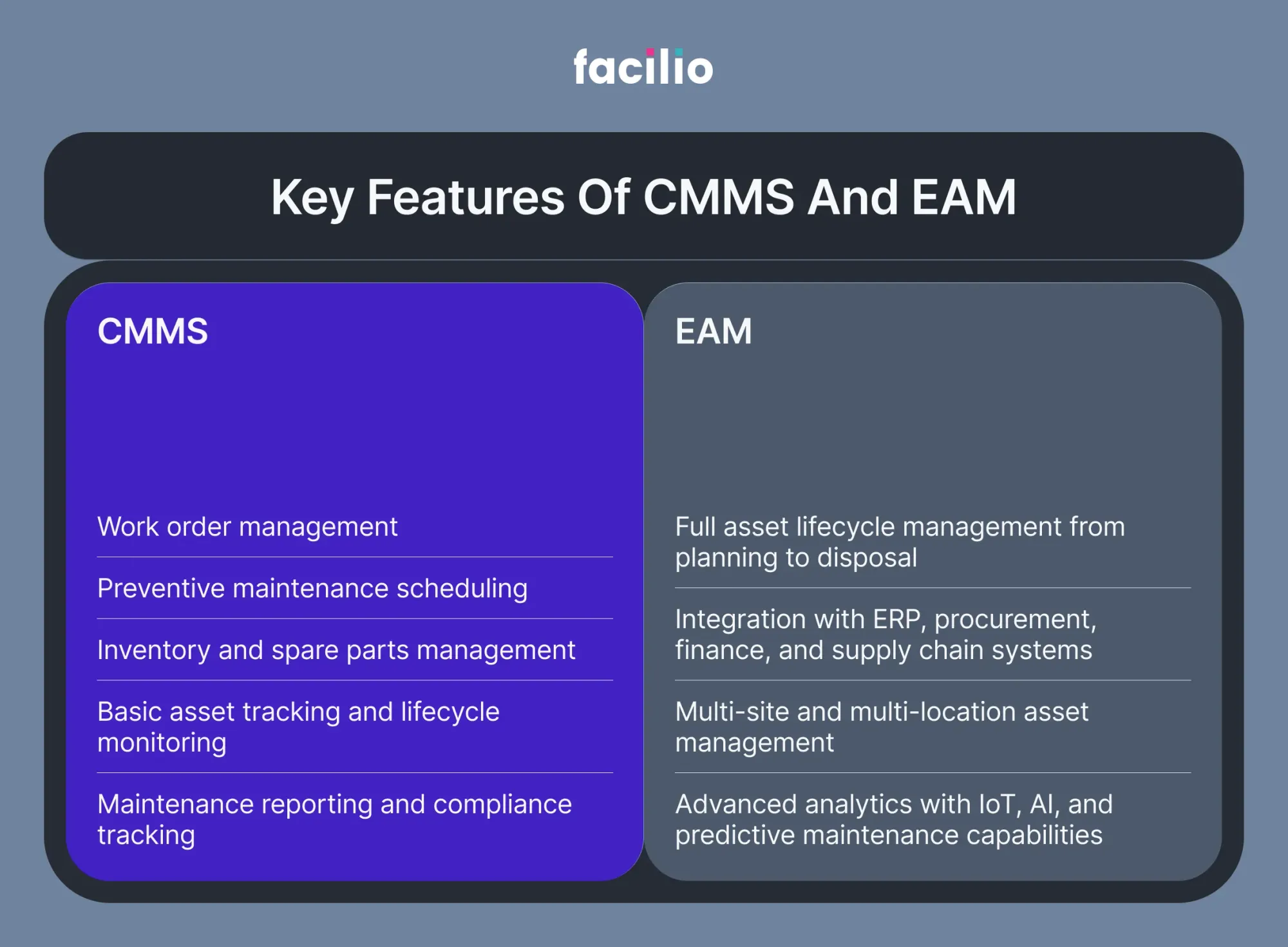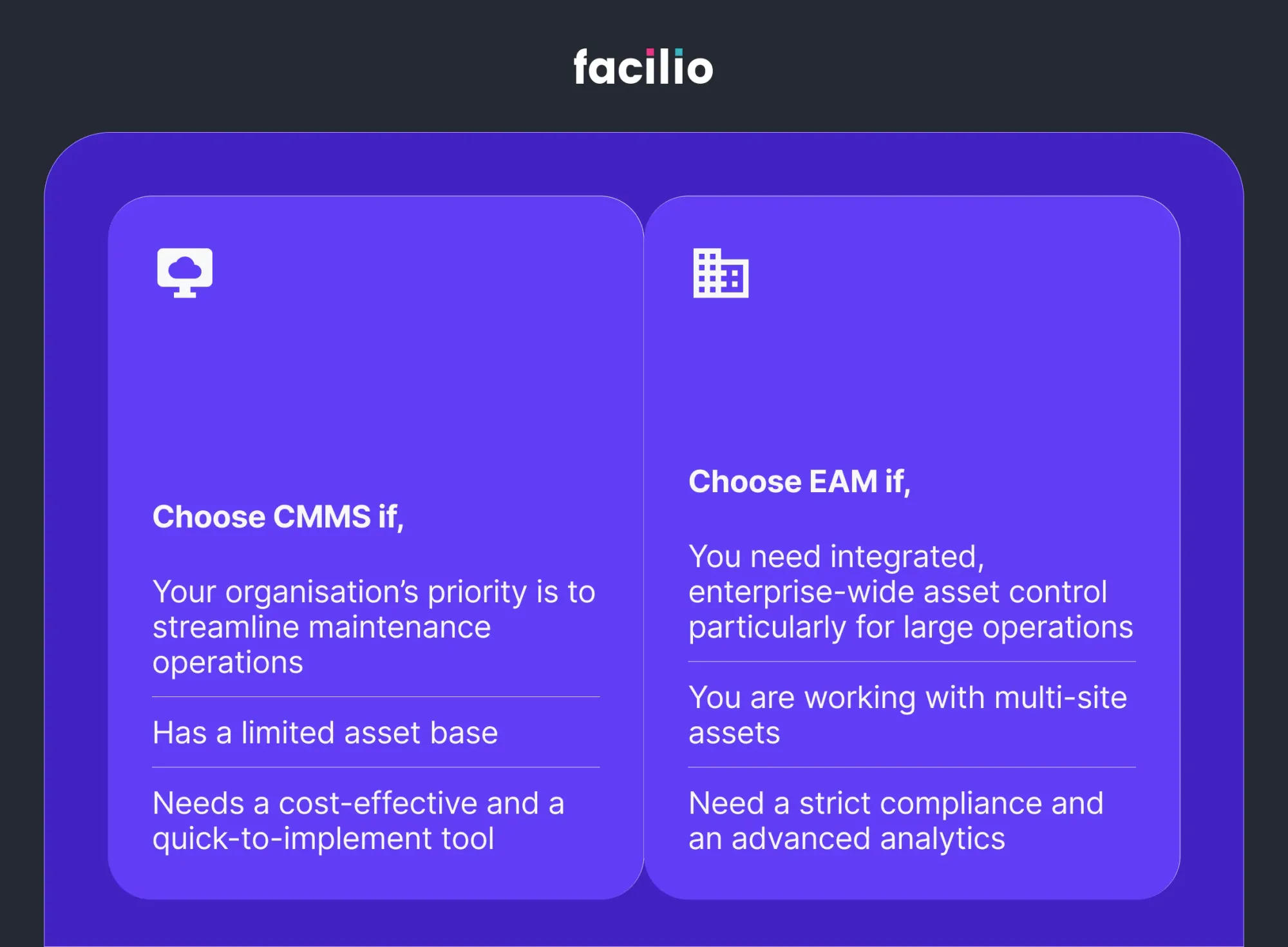Asset management is critical for maintaining operational efficiency and extending asset life in any organisation.
Two major software options in this space are - CMMS (Computerised Maintenance Management System) and EAM (Enterprise Asset Management). While they share similarities, knowing their differences will help you select the right fit for your business.
In this article, we'll break down the differences between CMMS and EAM, explain what they are, and help you determine which one is the right fit for your portfolio.
What is the difference between CMMS and EAM?

Now that we understand the basics, let's delve into the differences between CMMS and EAM.
Understanding the core differences helps you evaluate which system best suits your organisational needs. While both are valuable, they serve distinct purposes and scales of asset management.
This comparison highlights the primary areas where CMMS and EAM diverge, showing you the scope and capabilities of each solution.
CMMS vs EAM: Which one should you choose?
Choosing the right system ultimately depends on your organisation’s specific asset management challenges, size, and goals. Proper selection ensures you invest in the most fit-for-purpose technology.

Here are some considerations to help you make an informed decision:
- Business Needs
When evaluating maintenance and asset management solutions, it's essential to thoroughly assess your organisation's specific requirements.
If your organisation is planning for significant growth and requires a scalable solution that can evolve with changing needs, EAM might be a better fit. CMMS is more suitable for organisations with a narrower focus on maintenance.
- Integration
Compatibility with your existing systems is a vital aspect to consider when choosing a maintenance management solution. Easy integration with other software and hardware can significantly improve overall efficiency.
Look for a solution that offers easy integration capabilities, allowing you to streamline your maintenance and asset management processes.
CMMS often integrates well with ERP systems for streamlined maintenance and inventory management. EAM, on the other hand, provides more comprehensive integration, linking asset management with broader business processes like finance, HR, and supply chain through seamless ERP integration.
- User-Friendliness
Look for a user-friendly interface that requires minimal training for your team to adopt. Intuitive navigation and easy-to-use features will facilitate a smooth transition and maximise user adoption.
- Cost and Return on Investment
It's essential to evaluate the cost of implementation when selecting a maintenance management solution.
Consider factors such as licensing, training, and ongoing support. Also, assess the potential return on investment in terms of increased productivity, reduced downtime, and enhanced asset performance.
Industry-Specific Use Cases
Different industries face unique asset management challenges. Understanding how CMMS and EAM deliver value across sectors can clarify which solution aligns with your industry requirements.
These examples demonstrate how the two systems adapt to various operational environments, boosting efficiency and compliance.
- Manufacturing: EAM links asset data with production schedules & supply chains for uptime and cost control.
- Healthcare: CMMS ensures preventive maintenance and compliance for medical equipment.
- Transportation: EAM manages fleet lifecycles and meets regulatory requirements.
- Facilities Management: CMMS handles day-to-day building maintenance; EAM supports long-term asset planning.
How much do they cost & what's the RoI?
Cost considerations play a big role in selecting asset management software. Understanding pricing models alongside expected returns ensures you make a financially sound decision.
Here’s the price-to-value relationship between CMMS and EAM to help you assess total cost of ownership and ROI potential.
- CMMS: Lower upfront cost, faster deployment, minimal training needs, but limited scalability.
- EAM: Higher investment and longer rollout, but delivers stronger ROI in asset-intensive operations through reduced downtime, compliance efficiency, and improved decision-making.
When comparing options, factor in the total cost of ownership - software licensing, integrations, training, and ongoing support against the long-term operational gains.
What does Facilio offer
Selecting between CMMS and EAM ultimately boils down to your asset management requirements and organisational scale.
Both EAM and CMMS manage assets, but their scope differs. CMMS focuses on maintenance - work orders, scheduling, and inventory.
EAM encompasses the entire asset lifecycle, from acquisition to disposal, including:
- Proactive maintenance (often incorporating CMMS functionality)
- Asset tracking and lifecycle management
- Asset performance management and depreciation
- Energy optimization and reporting
Facilio's EAM goes beyond traditional CMMS with a connected platform that fosters collaboration and streamlines workflows for a holistic view of assets, optimizing performance, and achieving sustainability goals.
Frequently Asked Questions (FAQ)
1. What is the main difference between CMMS and EAM?
CMMS focuses on maintenance operations, while EAM manages the full asset lifecycle and business processes.
2. Can CMMS and EAM be used together?
Yes, some businesses start with CMMS and upgrade to EAM as asset management needs grow.
3. Which industries benefit most from EAM?
Large asset-intensive industries like manufacturing, transportation, energy, and healthcare benefit from EAM’s comprehensive management.
4. How does EAM improve compliance and audits?
EAM provides detailed tracking, documentation, and workflows to ensure regulatory requirements are met.
